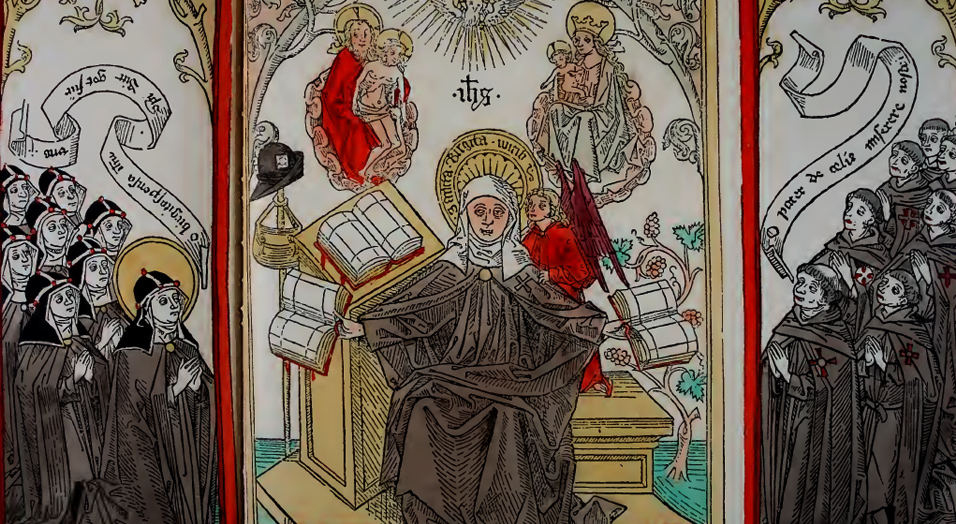The central panel has many of the features seen in woodcuts of this saint. The writing desk is a common element, referring not only to the Rule but to her many visionary works and her correspondence with the leading figures of the age. Left of the desk, a walking staff supports a pilgrim's hat and scrip. These refer to Bridget's pilgrimages to Compostela, Jerusalem, and Rome. As seen in
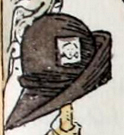 the detail at left, the hat has a "veronica" badge, an image of the face of Jesus purported to be imprinted on Veronica's veil. In a cloud above and to the right of the hat, God the Father cradles the naked body of the Son, as in Throne of Mercy and Death of Jesus images. This is mirrored by the image on the right of the Virgin Mary cradling the naked Christ Child. Small insets of this kind are common in the images; in others we may see the Father with the Virgin, the Virgin with the Son in Heaven, or a Pietà. Mary's golden crown with three trefoils is also seen in many Brigittine images of this era, often at the saint's feet. Between these two figures and directly above Bridget's halo is the ihs monogram that represents the name of Jesus. Above that the Holy Spirit hovers in the form of a dove.
the detail at left, the hat has a "veronica" badge, an image of the face of Jesus purported to be imprinted on Veronica's veil. In a cloud above and to the right of the hat, God the Father cradles the naked body of the Son, as in Throne of Mercy and Death of Jesus images. This is mirrored by the image on the right of the Virgin Mary cradling the naked Christ Child. Small insets of this kind are common in the images; in others we may see the Father with the Virgin, the Virgin with the Son in Heaven, or a Pietà. Mary's golden crown with three trefoils is also seen in many Brigittine images of this era, often at the saint's feet. Between these two figures and directly above Bridget's halo is the ihs monogram that represents the name of Jesus. Above that the Holy Spirit hovers in the form of a dove.
Some images of St. Bridget are like the first picture at right in portraying one of her customary acts of penitence, as described in her earliest vita:
On Fridays she would pour burning drops from a wax candle onto her bare flesh, leaving wounds. If sometimes the wounds would heal before the next Friday, she would scratch them open with her fingernails.… This she did on account of the Passion of Jesus Christ.1According to Duchet-Suchaux (70) other attributes include a set of five little red flames and a flaming heart or a heart marked with a red cross.
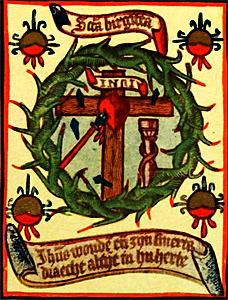 I have not yet seen any images of Bridget with these attributes, but Collijn (67-69) does have an image of a pierced heart on the Cross framed by the Crown of Thorns and with other items of the Arma Christi beneath the legend Sancta Birgitta. He discusses a similar image on pages 71-73. Indeed, most of images of this saint strive to express her devotion to the Passion of Christ in one way or another.
I have not yet seen any images of Bridget with these attributes, but Collijn (67-69) does have an image of a pierced heart on the Cross framed by the Crown of Thorns and with other items of the Arma Christi beneath the legend Sancta Birgitta. He discusses a similar image on pages 71-73. Indeed, most of images of this saint strive to express her devotion to the Passion of Christ in one way or another.
ST. BRIDGET AND NATIVITY IMAGES
Bridget of Sweden had a strong influence on the iconography of the Nativity. In her Revelations she told of a vision she had in Bethlehem in which the Virgin Mary recounted the birth to her:
The Revelations were famous throughout Europe and in very little time it became customary for images of the Nativity to show Mary and Joseph kneeling before a "naked and glowing" Christ Child in the stable, as in the second picture at right.I saw that glorious infant lying on the earth, naked and glowing in the greatest of neatness.… When therefore the Virgin felt that she had now given birth, at once, having bowed her head and joined her hands, with great dignity and reverence she adored the boy and said to him: "Welcome, my God, my Lord, and my Son!" And then the boy, crying and, as it were, trembling from the cold and the hardness of the pavement where he lay, rolled a little and extended his limbs, seeking to find refreshment and his Mother's favor.… When these things therefore were accomplished, the old man [Joseph] entered; and prostrating on the earth, he adored him on bended knee and wept for joy.2
Prepared in 2014 by Richard Stracke, Emeritus Professor of English, Augusta University, revised 2015-10-16.
A woodcut from about 1480. See the description page for an unclipped copy and further details.
OTHER IMAGES: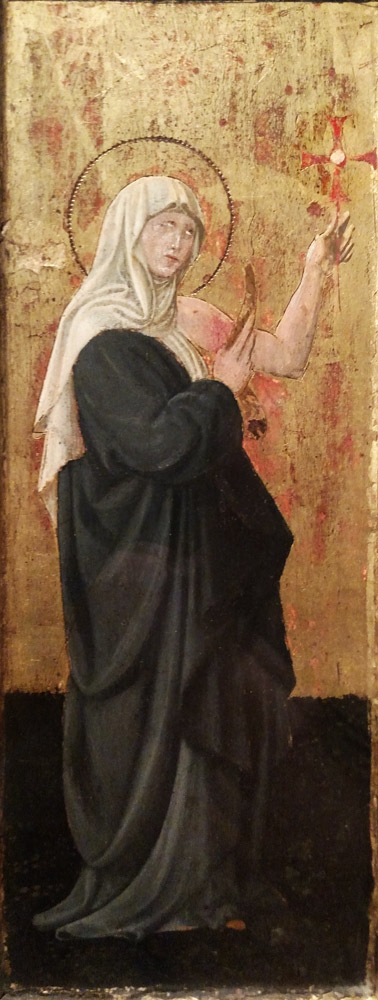
St. Bridget with the burning candle and red cross (See the description page)
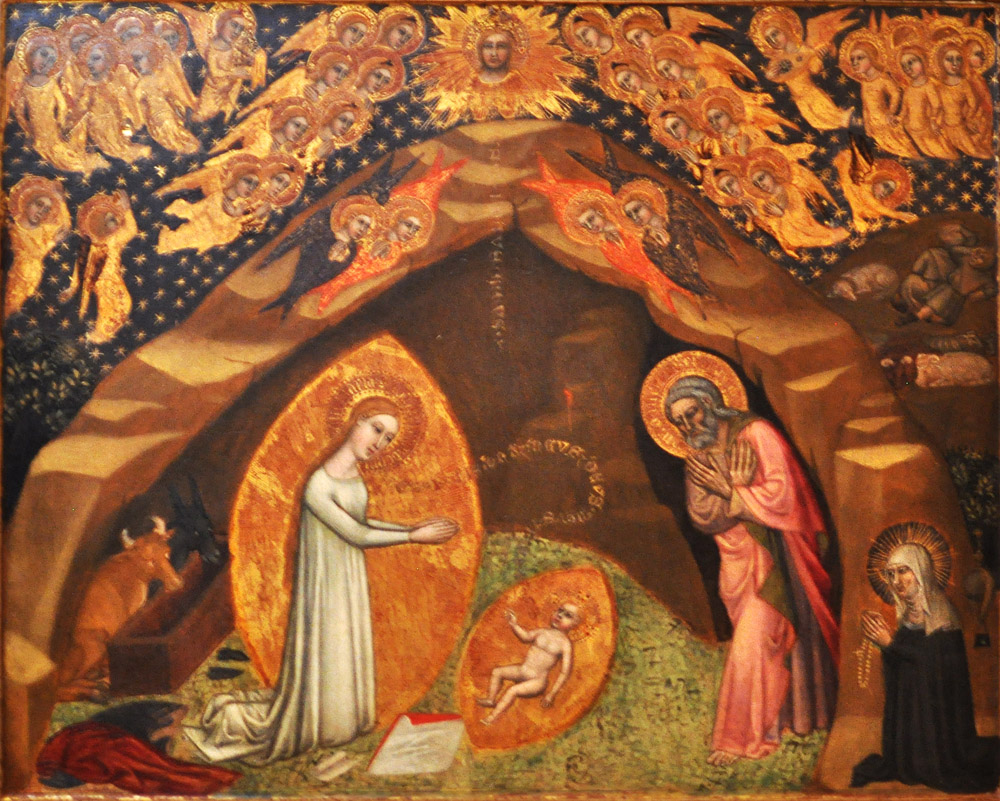
This painting is the earliest artistic representation of Bridget's vision of the Nativity. (See the description page.)
MORE IMAGES
- 1459: An allegorical marble plaque of St. Bridget receiving the rule of her order from Jesus.
- 1753: In the margin of a Mexican nun's badge.
DATES
- Bridget's feast day is now July 23, the day of her death. Before the 20th century it was October 8, the day of her canonization in 1391.
- The saint lived 1303-73.
NAMES
- Also known as St. Birgitta
BIOGRAPHY
- Bridget's vita in The Roman Breviary: English translation, IV, 635-36; Latin original, 1063-64
- Acta Sanctorum, October vol. 4, 368-560 (includes on pages 485-495 a brief vita written by the Archbishop of Uppsala in the 14th century and a longer one on pages 495-534 written by an Italian Brigittine in the 15th).
HIGHLY RECOMMENDED
- Isak Collijn, Iconographia Birgittina Typographia surveys early woodblock images of St. Bridget.
NOTES
1 Translated by me from the Acta Sanctorum, October vol. 4, 491. The same is asserted in the 15th-century vita on page 511.
2 Text: The Prophecies and Revelations of Saint Bridget of Sweden, VII, 21. Image: Collijn, 23.
